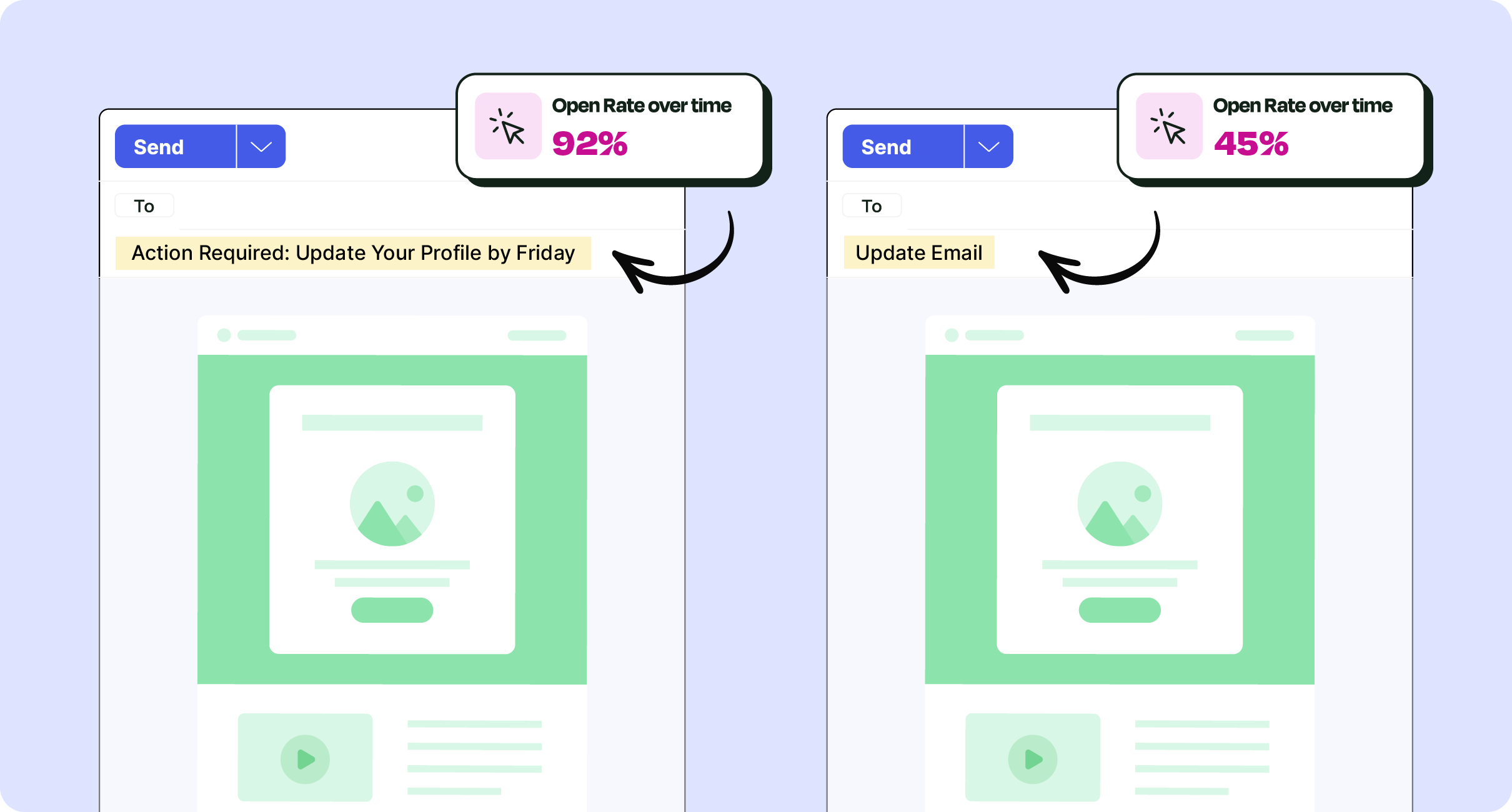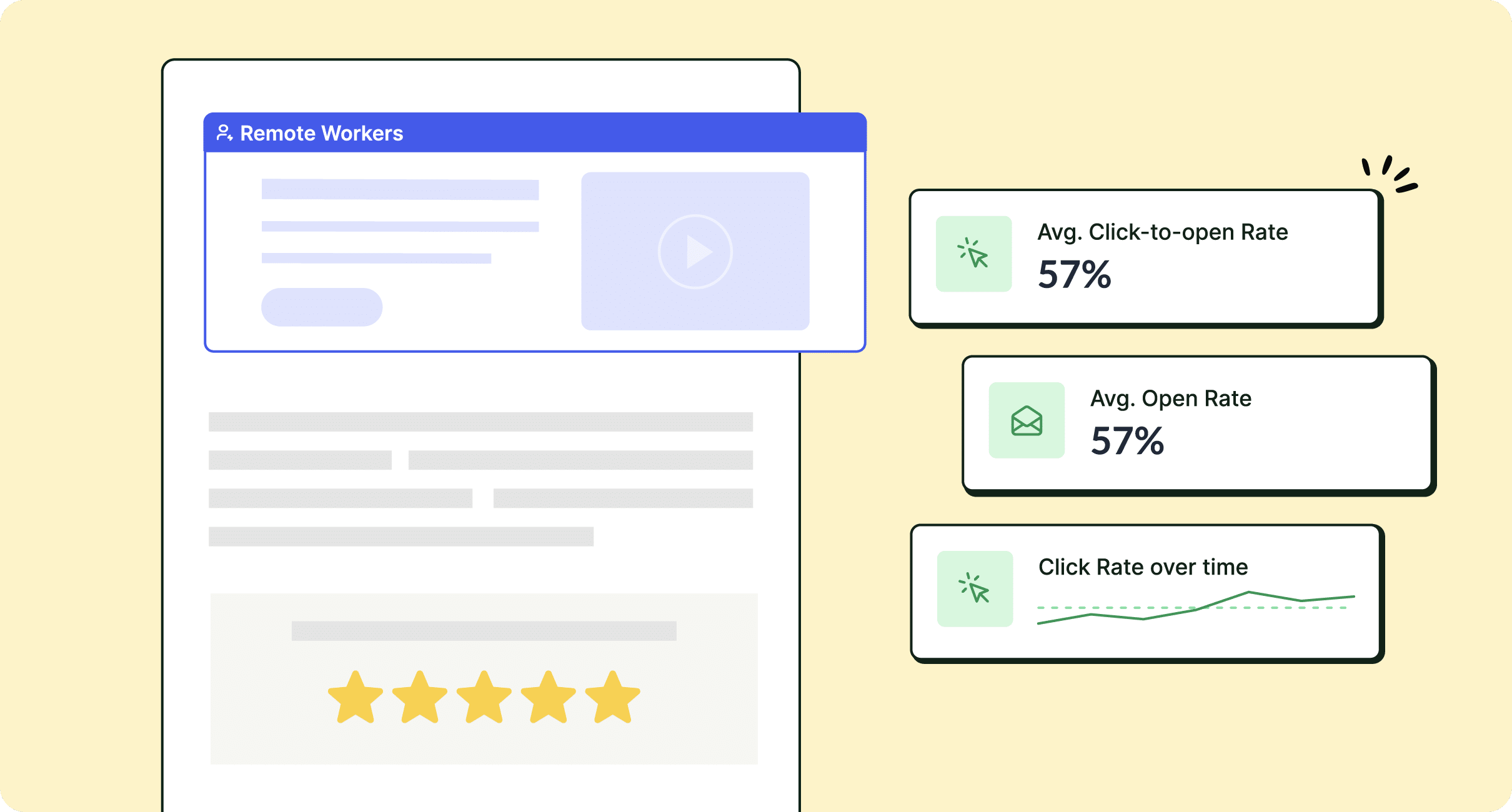Are employees skipping over your emails or not engaging as you’d like? We may have the answers. Read along for the must-have types of internal emails that boost employee engagement.
Leveraging the best types of employee emails for your goals will inspire action and strengthen your internal communications. Each internal email type plays a specific role, and knowing how and when to use them will make a world of difference.
When you pair the right messages with the right types of internal emails, you can transform basic announcements into internal communication campaigns.
In this post, we’ll explore 7 types of internal emails with examples that keep staff aligned and motivated. We’ll also show how an integrated internal email platform will enhance Outlook or Gmail with powerful analytics, audience segmentation, and more.
Take a self-guided tour of ContactMonkey
See how our key features can streamline your internal communications.
Take product tour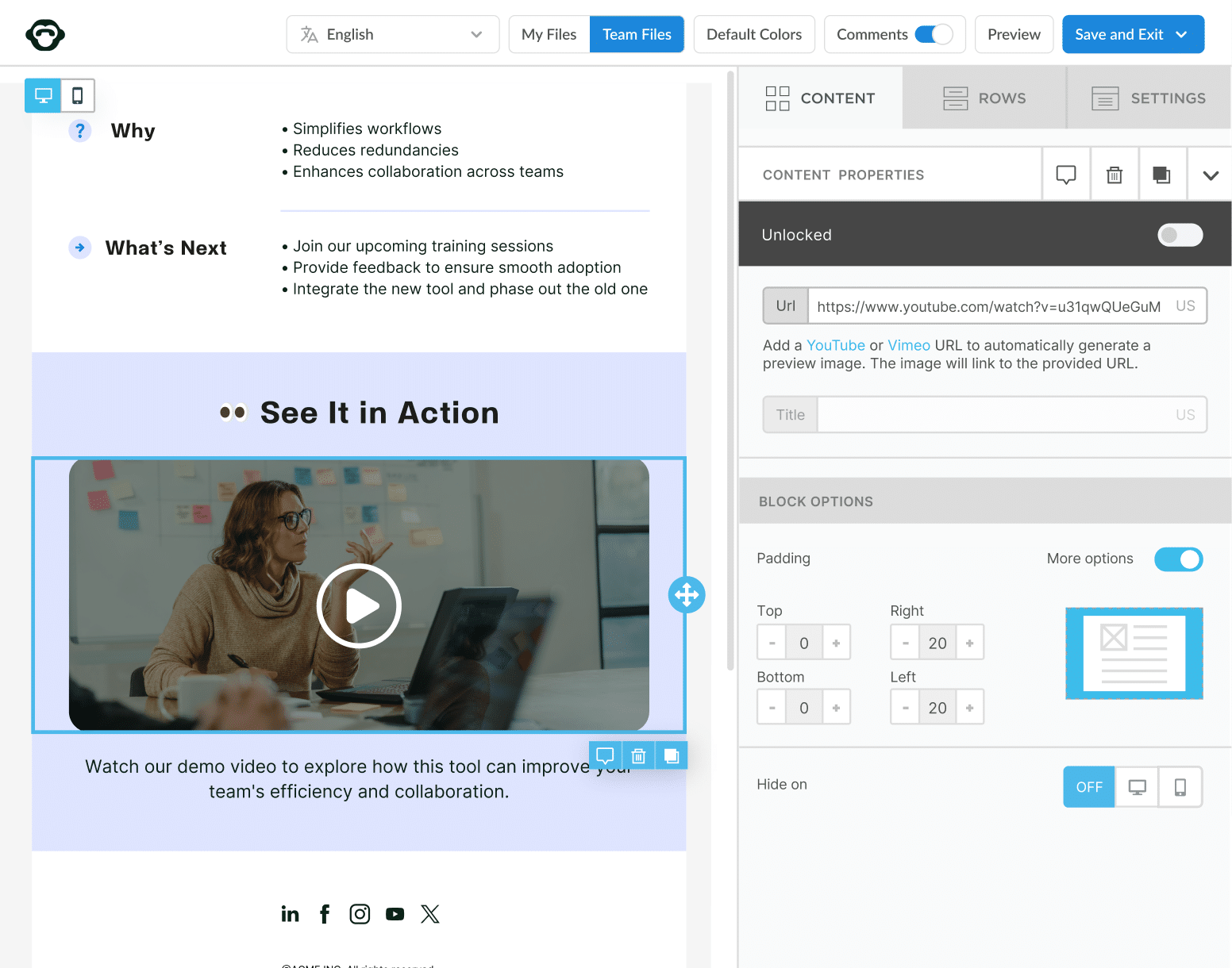
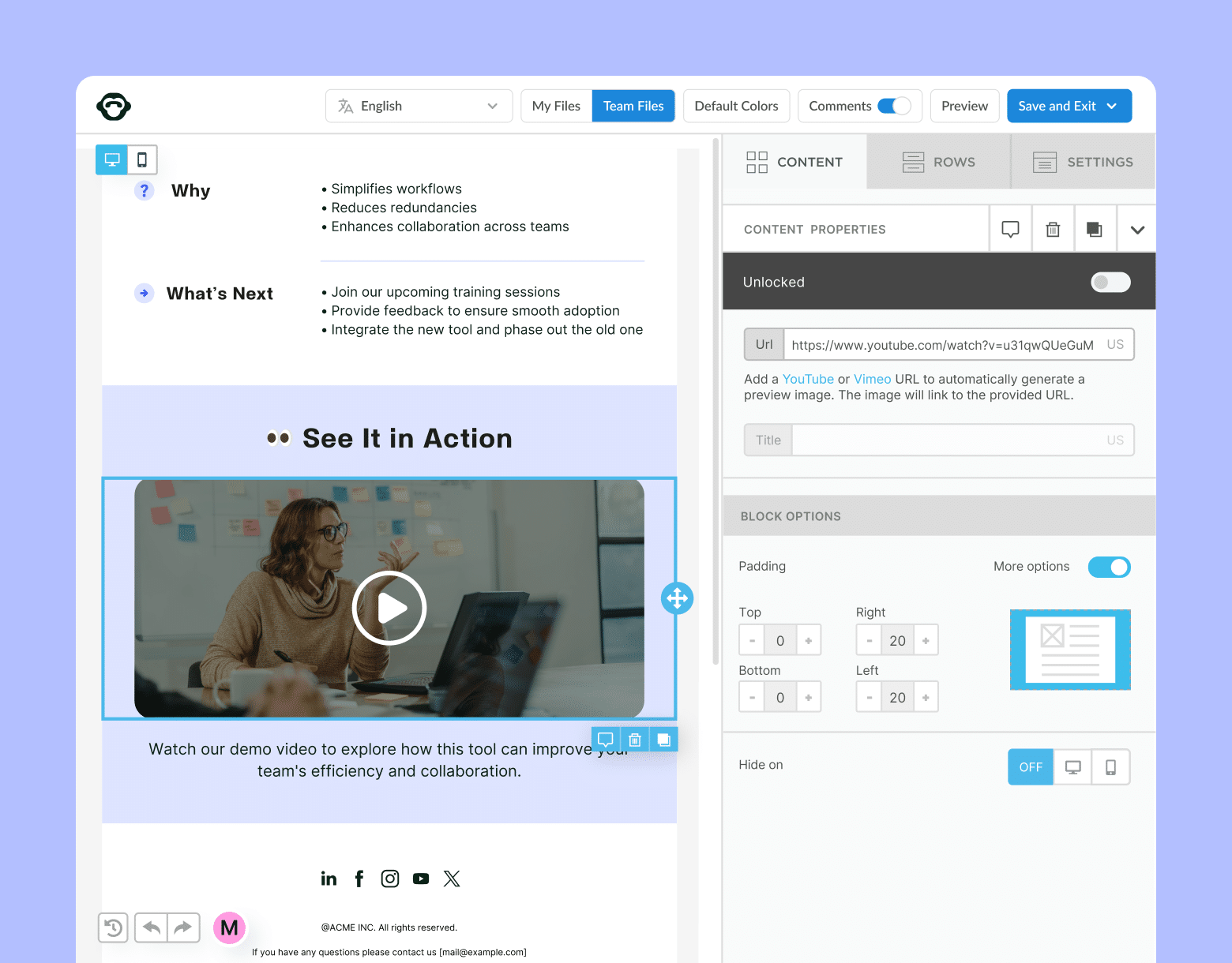
Why Send Internal Emails to Staff?
Organizations of all sizes rely on types of internal emails to keep employees informed and aligned. The benefits of a strong internal comms practice include improved internal email engagement rates, better overall employee engagement, and a stronger feedback culture. Here are a few key benefits of internal emails:
- Improves internal communications: Regularly sending the most important types of internal emails with examples will reduce confusion and increase dialogue.
- Boosts employee engagement: Targeted types of employee emails—like employee recognition or feedback requests—show employees that their contributions matter.
- Creates valuable feedback channels: When staff receive employee emails encouraging responses, they’re more likely to share insights.
- Unlocks analytical insights: Modern email solutions offer better internal email campaign analytics, like open rates, clicks, and engagement for better decision-making.
- Streamlines communications: Different types of internal communication emails prevent information overload and ensure relevance.
Ultimately, these types of internal emails help foster a culture of trust and transparency that unites everyone.
Using a Modern Internal Email Platform
While Outlook and Gmail are the most common platforms for sending internal emails, they lack advanced features that transform internal communication into a strategic asset. A robust internal email platform unlocks game-changing features like:
- Advanced analytics: Real-time metrics on open rates and engagement.
- Segmentation and personalization: Send types of employee emails to relevant groups for higher impact.
- Templates and branding: According to our Global State of Internal Communications report, the majority of IC time goes to creating content and templates. Professional, on-brand internal email templates save time here.
- HRIS Integrations: Seamlessly connect your email platform with your existing HRIS to ensure employee lists are always up-to-date without manual labor.
- Interactive content opportunities: Include polls or surveys in internal emails for instant feedback and valuable insight.
By adopting a specialized internal email tool platform—like ContactMonkey—you can create, send, and track messages far more efficiently than with standard email clients.
7 Types of Internal Emails to Send Regularly to Employees
Below are 7 types of internal emails with examples you should consider sending regularly. Each helps you align teams, boost morale, and streamline communication in your overall internal comms email strategy.
Create internal emails that get opened and read
No design or technical expertise needed. Save time, increase engagement, and dazzle your employees with fun and interactive communications.
Explore email features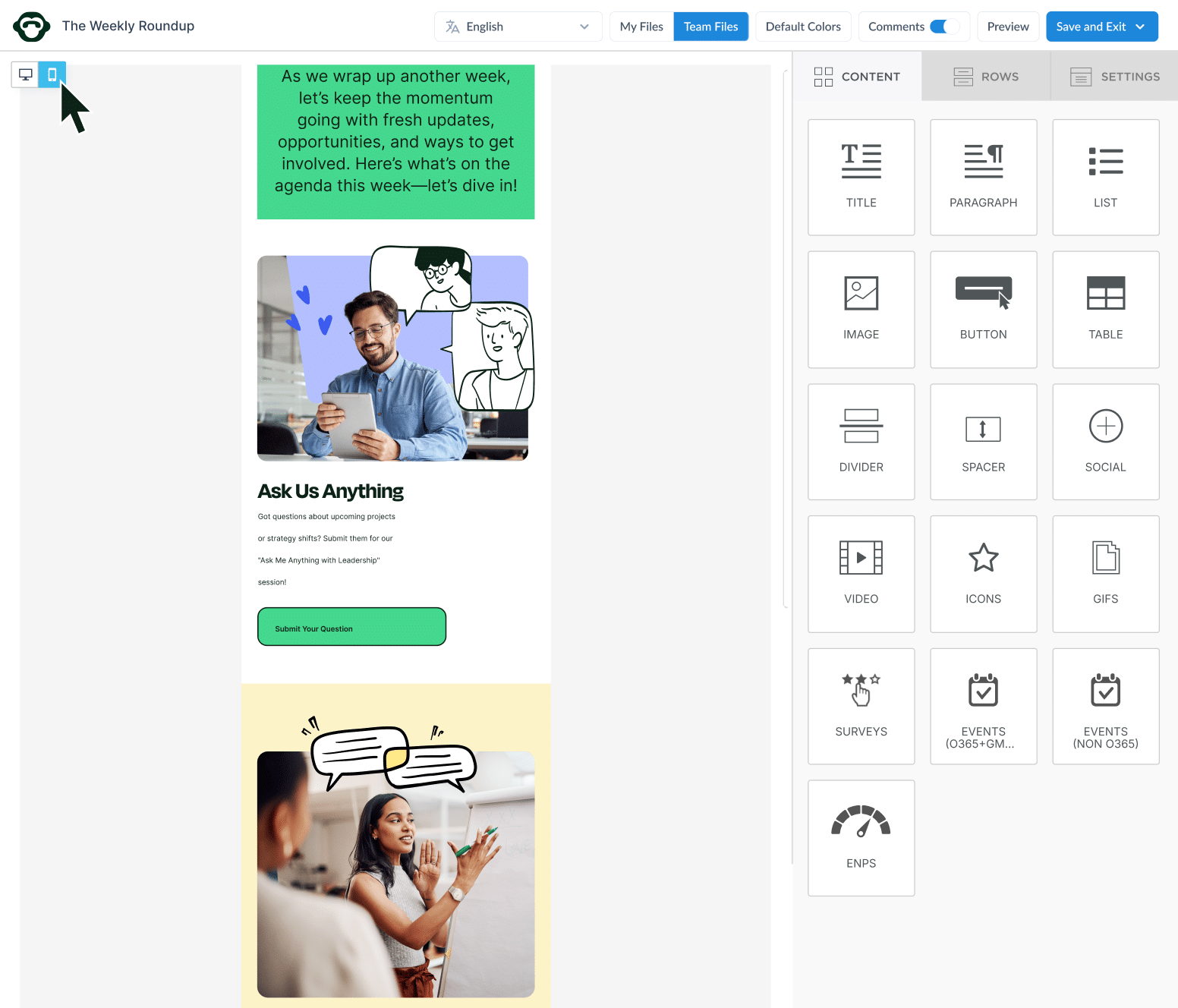
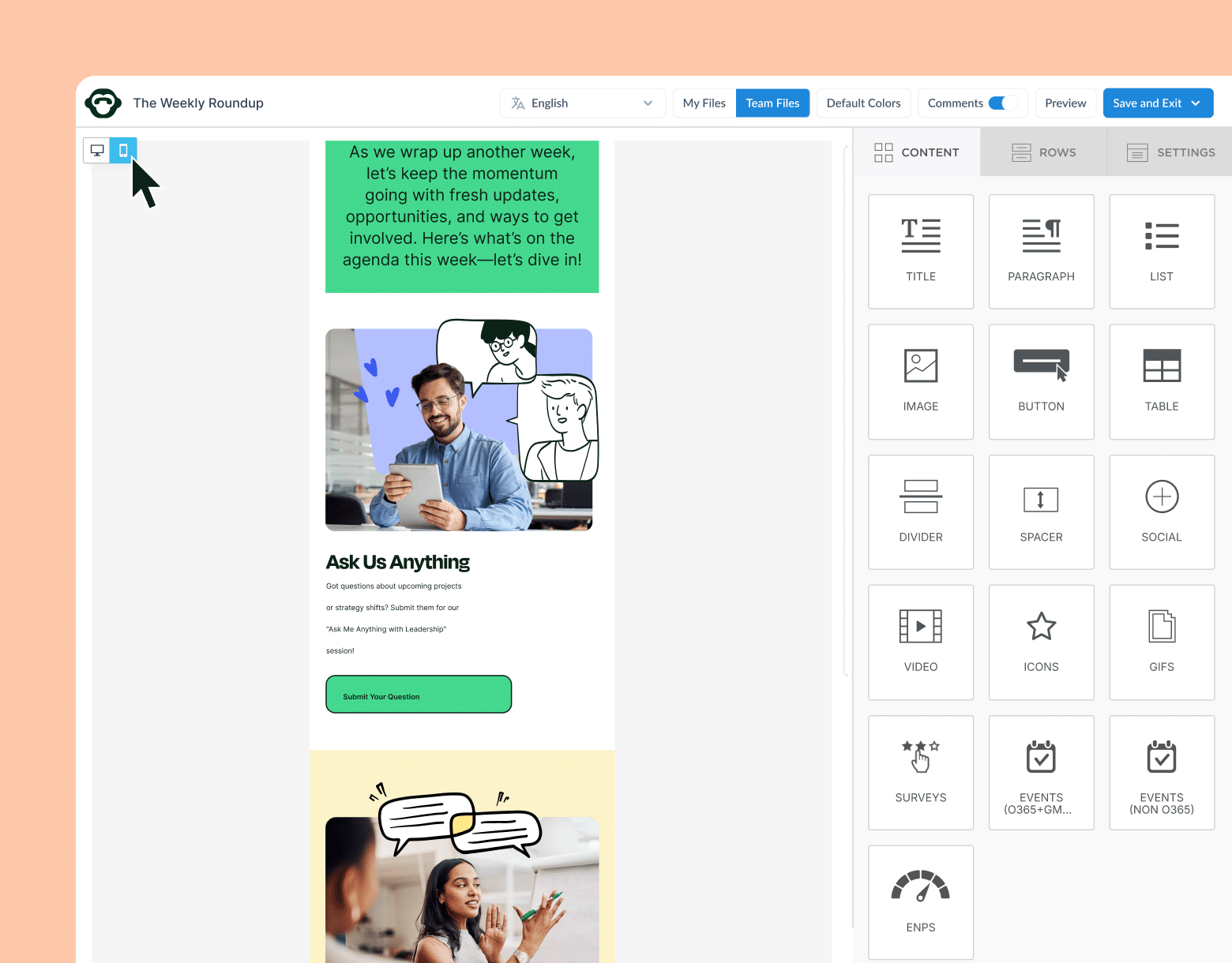
1. Onboarding and new employee introduction emails
These emails welcome new hires and exemplify types of internal emails that create a strong first impression. They shape an employee’s initial experience helping you boost retention and engagement.
Why it matters: Making newcomers feel supported from day one increases job satisfaction and reduces turnover.
Benefits of this internal email type:
- Sets a welcoming tone and reduces first-day nerves.
- Provides essential information about company culture and role expectations.
- Encourages early engagement and proactive communication.
When to send this email: Issue these emails immediately after a new hire signs the offer or on their first official day.
Tips for developing this email:
- Include a friendly welcome note and key contact details.
- Provide an overview of company values, policies, and training resources.
- Encourage questions to foster an open-door atmosphere.
Practical examples of this email type:
- “Welcome Aboard!” email with a schedule for orientation and links to training modules.
- “Meet the Team” introduction featuring short bios and friendly photos.
- “Your First Week” outline covering tasks, goals, and important milestones.
PRO TIP
Use employee email tools with list management features to segment new hires by department, ensuring each individual sees only relevant orientation details and checklists
2. Company culture and values emails
These messages spotlight your organization’s beliefs, vision, and mission, showcasing types of internal emails that unite teams around common goals. By featuring real-life examples of values in action, they illustrate examples of internal emails that strengthen a cohesive identity.
Why it matters: Regular culture-focused messages keep employees aligned with the organization’s guiding principles, boosting cohesion and morale.
Benefits of this internal email type:
- Reinforces what the company stands for.
- Highlights positive behaviors and success stories.
- Fosters a sense of belonging and purpose among staff.
When to send this email: Share monthly, quarterly, or around major events that showcase or require strong company values (e.g., big projects, and community initiatives).
Tips for developing this email:
- Include success stories or employee spotlights that exemplify company values.
- Use visuals like infographics or short videos to engage your audience.
- Maintain a positive, inclusive tone to resonate with diverse teams.
Practical examples of this email type:
- “Culture Spotlight” section that highlights employees who displayed a value of the organization.
- “Living Our Values” newsletter explaining how a crucial decision was guided by your mission.
- “Core Beliefs Refresher” with an interactive quiz testing knowledge of the company’s values.
Watch ContactMonkey LIVE in action
Join live demo
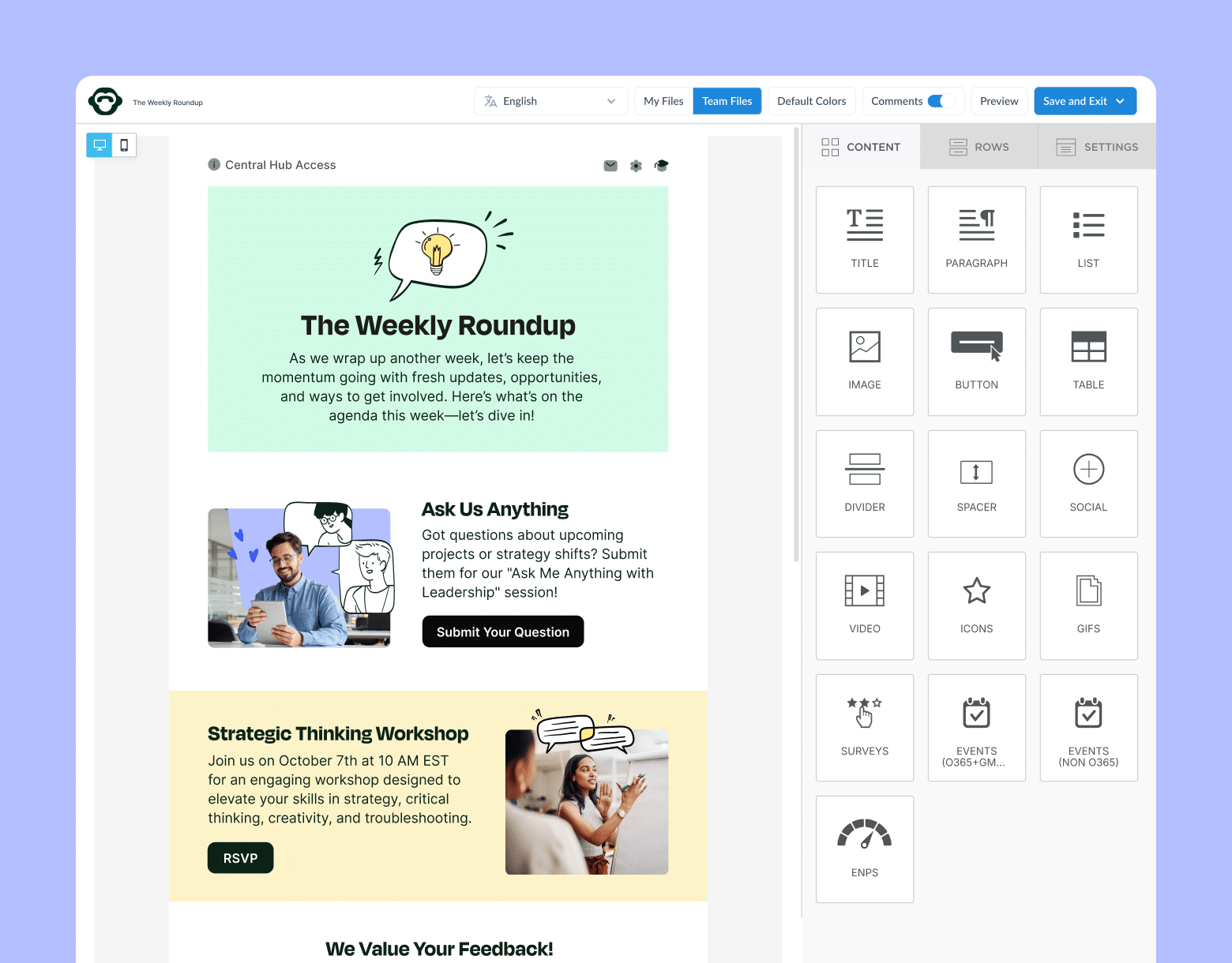
🎁 BONUS
Read our article on internal email best practices to learn more about developing, deploying, and measuring internal emails.
3. Company policy update emails
Policy updates are types of internal communication emails that inform employees of any changes to guidelines or procedures. They serve as types of employee emails that clarify expectations and prevent confusion, often using types of internal emails with examples for quick reference.
Why it matters: Prompt, transparent policy updates support compliance and preserve trust within your workforce.
Benefits of this internal email type:
- Ensures employees stay informed of the latest rules and procedures.
- Reduces the risk of non-compliance and costly mistakes.
- Creates a record of communication for future reference.
When to send this email: Distribute immediately after any policy changes—legal updates, new HR guidelines, or altered security protocols.
Tips for developing this email:
- Summarize the updated policy in clear, concise language.
- Provide context: why the change is happening and what it impacts.
- Link to official documents or FAQs for in-depth information.
Practical examples of this email type:
- “New PTO Policy” email detailing added mental health or volunteer days.
- “Remote Work Guidelines” update clarifying hours and communication expectations.
- “Data Security Changes” announcement outlining steps to protect sensitive info.
PRO TIP
With ContactMonkey’s email analytics features, you can track open rates to confirm employees have seen and acknowledged the policy changes.
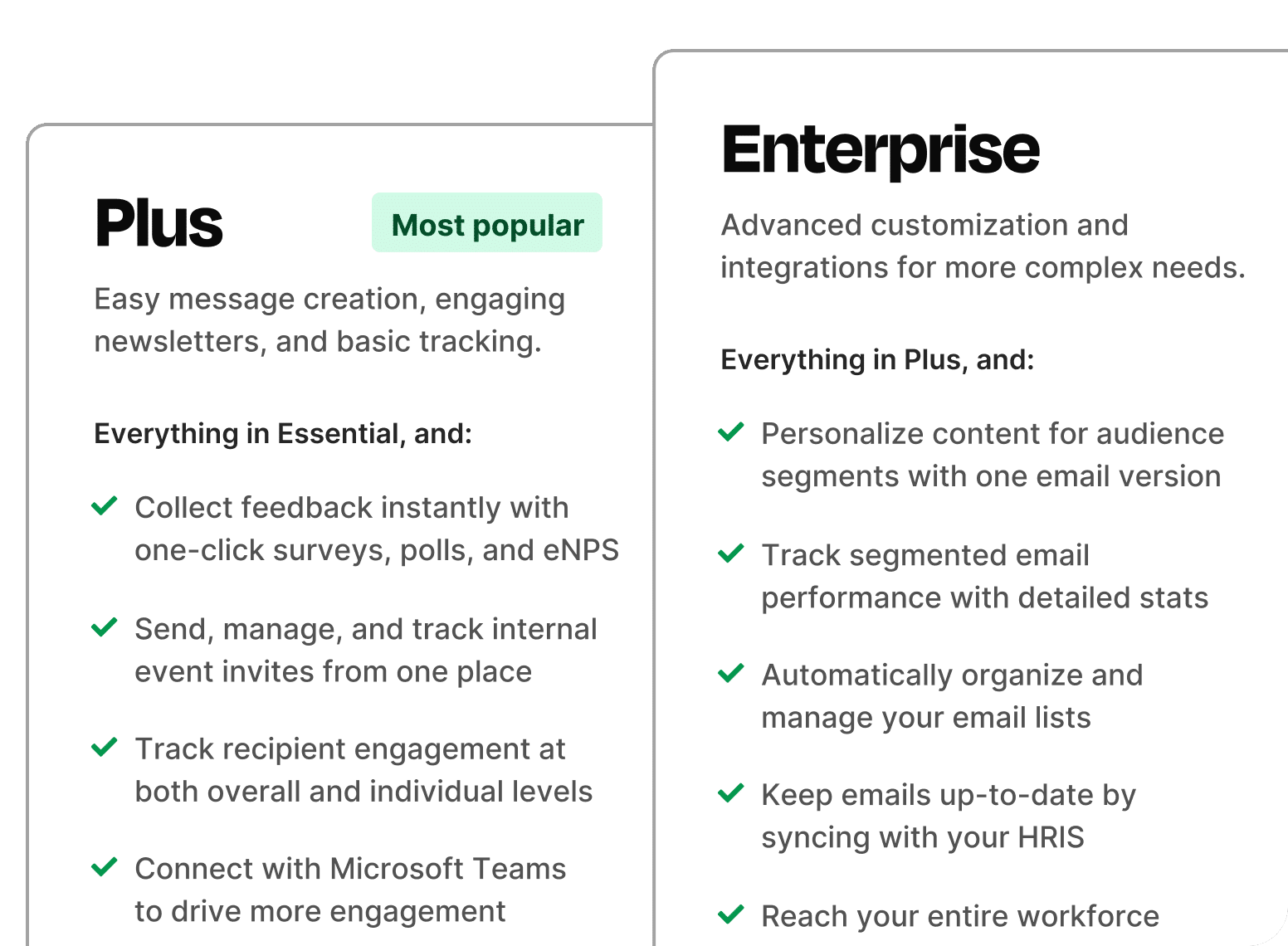
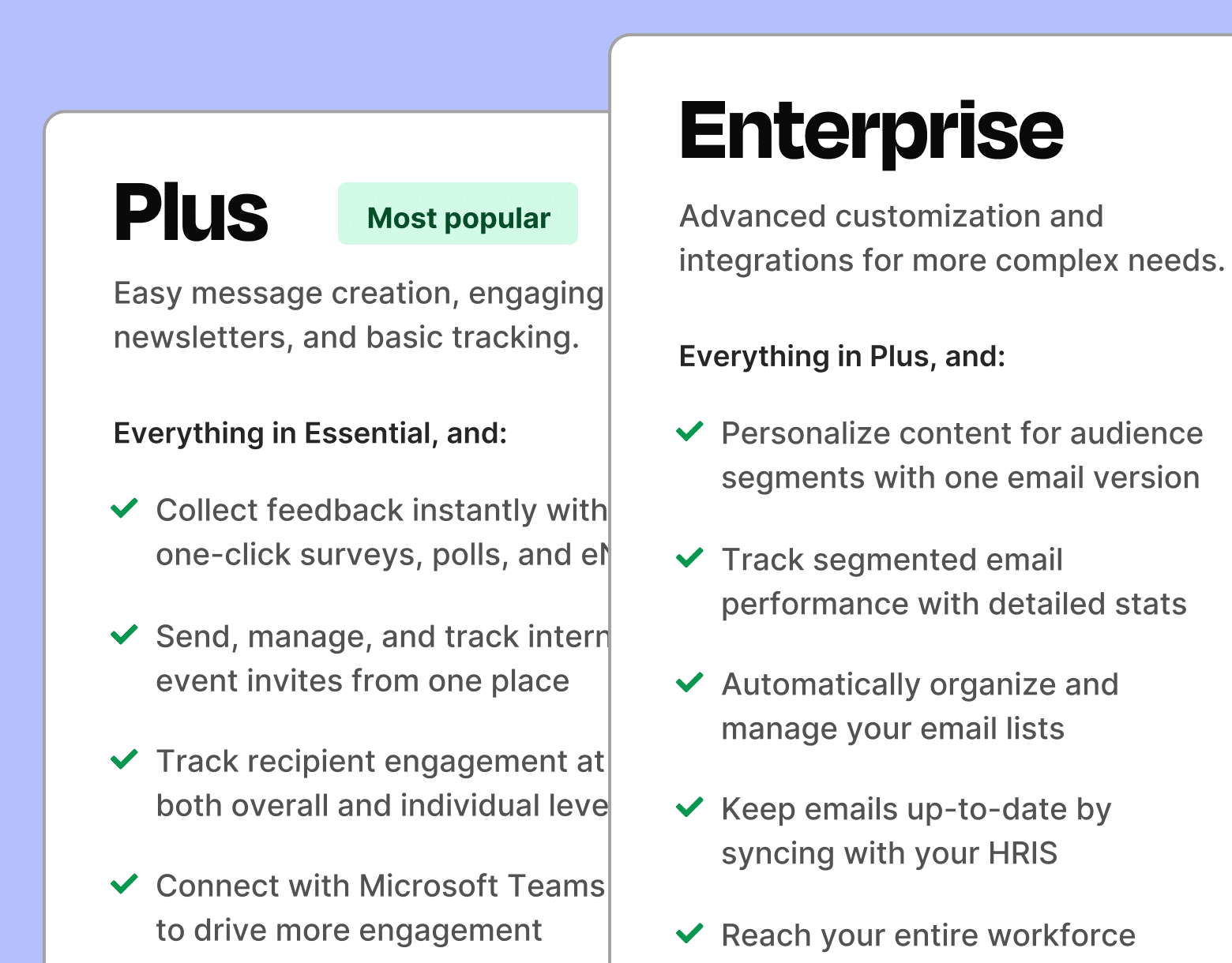
4. Event announcements and invitations
Event announcements are types of internal emails that inform employees about gatherings, training sessions, or social functions. They also act as types of employee emails that spark interest and encourage attendance, aligning with your internal comms email strategy.
Why it matters: Clear event invites help employees schedule, prepare, and stay engaged with company activities.
Benefits of this internal email type:
- Boosts attendance and enthusiasm for company-hosted events.
- Helps employees feel included in organizational happenings.
- Simplifies planning by collecting RSVPs and feedback in one place.
When to send this email: Send at least two weeks before major events; follow up with reminders a few days prior.
Tips for developing this email:
- Provide all core details (date, time, location, purpose).
- Use an engaging subject line or design to spark interest.
- Include RSVP or sign-up links for easy response tracking.
Practical examples of this email type:
- “Save The Date” for a quarterly town hall with a brief agenda outline.
- “Company Holiday Party” invite featuring a festive design and RSVP button.
- “Team-Building Workshop” announcement including a poll for preferred activities.
PRO TIP
Try internal communication email example templates in ContactMonkey’s email template builder feature to add interactive elements—like embedded polls—to gauge interest in potential event themes or breakout sessions.
Modern internal comms and measurement tools
No design or technical expertise needed. Save time, increase engagement, and dazzle your employees with fun and interactive communications.
Explore all features

5. Leadership and executive updates
Leadership updates are pivotal types of internal communication emails featuring high-level insights and organizational vision. As influential types of employee emails, they guide how staff perceives strategy, performance, and future goals.
Why it matters: Direct communication from executives fosters transparency, trust, and alignment with the organization’s vision.
Benefits of this internal email type:
- Informs employees about overall performance and changes.
- Encourages buy-in for new initiatives.
- Demonstrates an open-door policy from upper management.
When to send this email: Distribute quarterly for performance results, or whenever major strategic shifts occur (e.g., mergers, acquisitions, leadership transitions).
Tips for developing this email:
- Convey authenticity and clarity in the tone.
- Provide context for decisions and invite questions or feedback.
- Align messages with overarching company goals or values.
Practical examples of this email type:
- “CEO’s Quarterly Address” summarizing revenue, milestones, and next targets.
- “Strategic Pivot” detailing how and why the company is shifting focus.
- “New Executive Welcome” announcing a C-level hire with background and vision.
PRO TIP
With employee email software like ContactMonkey, you can measure engagement to see if staff resonates with executive announcements—an essential part of any internal communications email strategy.
6. Employee recognition and appreciation emails
Recognition emails are types of internal emails focused on applauding achievements and highlighting positive contributions. They serve as types of employee emails that boost morale by showcasing success stories.
Why it matters: Timely praise fosters motivation, loyalty, and a culture of gratitude.
Benefits of this internal email type:
- Boosts employee satisfaction and retention.
- Encourages others to strive for similar achievements.
- Nurtures a positive environment where hard work is seen and rewarded.
When to send this email: Immediately following a noteworthy accomplishment, or on a scheduled basis (e.g., monthly awards).
Tips for developing this email:
- Be specific about what the employee or team did well.
- Illustrate the impact of their achievement on broader goals.
- Encourage a celebratory reply from peers or leaders.
Practical examples of this email type:
- “Employee Of The Month” spotlighting key accomplishments and quotes.
- “Milestone Celebration” email praising a team for hitting a major project deadline.
- “Innovation Kudos” highlighting an individual’s creative solution to a problem.
Get powerful send features with ContactMonkey
Create custom audiences, increase content relevancy, and improve employee email engagement.
Learn more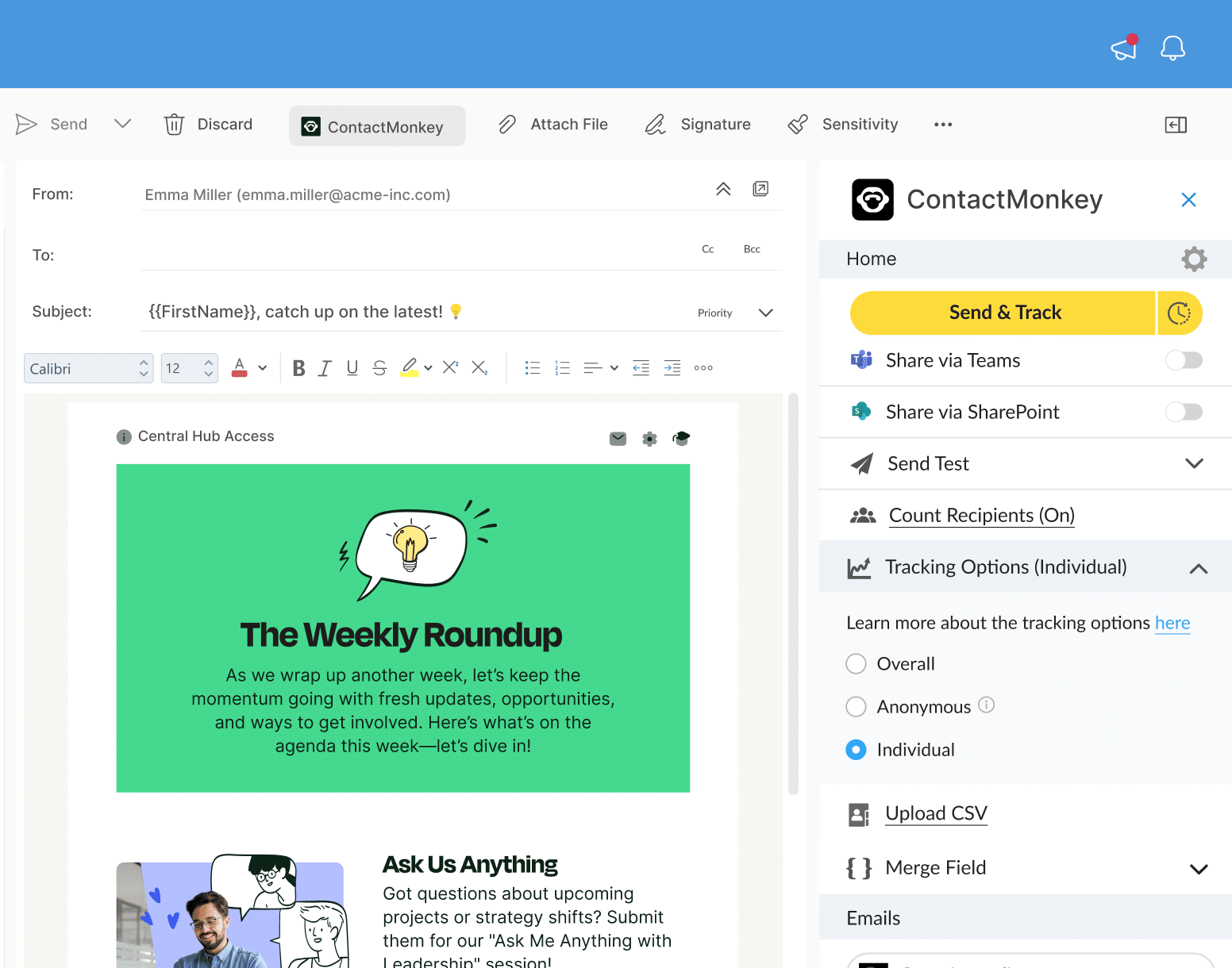
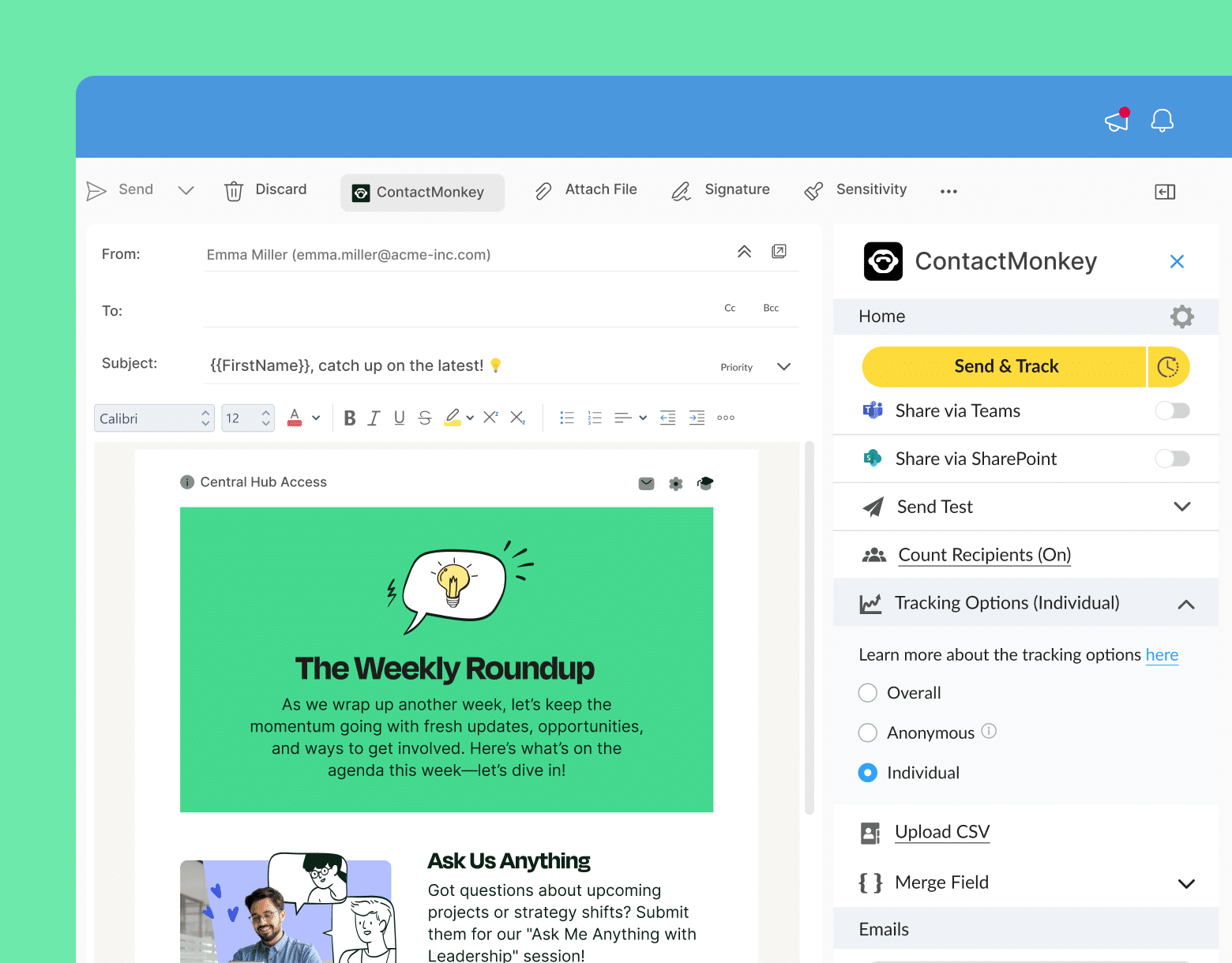
🎁 BONUS
Save this internal email checklist so you can refer back once you’re ready to develop your internal communication email templates.
7. Alert and emergency emails
Alert and emergency emails are high-priority types of internal emails conveying urgent information. They exemplify types of employee emails that require immediate attention for real-time action and safety.
Why it matters: These emails help safeguard employee well-being, preserve trust, and prompt swift action in critical situations.
Benefits of this internal email type:
- Rapid dissemination of essential instructions.
- Clear communication channels during a crisis.
- Improved safety and compliance across the organization.
When to send this email: Issue these emails the moment an emergency occurs or when crucial information becomes available (e.g., severe weather alerts, or system outages).
Tips for developing this email:
- Use an attention-grabbing subject line with words like “Urgent” or “Alert.”
- Keep the message concise, focusing on the essential steps.
- Provide clear next actions and relevant contact information.
Practical examples of this email type:
- “Office Closure Notice” due to extreme weather, including instructions for remote work.
- “System Outage Alert” detailing the issue, expected resolution time, and workarounds.
- “Health Advisory” sharing precautions and safety measures.
PRO TIP
With a specialized internal communications email platform like ContactMonkey, you can instantly broadcast these alerts to segmented lists and track who opens them through internal email reports. Plus, you can couple your email sends with SMS communication for multi-channel delivery.
How ContactMonkey Helps You to Send the Best Internal Emails
Whether you’re distributing crucial policy updates, inviting staff to upcoming events, or seeking feedback on recent initiatives, ContactMonkey streamlines each step of the process. Here’s a look at the key features that make ContactMonkey the right platform to integrate with your existing Outlook or Gmail:
- Drag-and-drop email builder: Create polished, on-brand emails without needing HTML expertise. Customize layouts, add media, and insert dynamic elements to keep readers engaged.
- Audience segmentation: Target specific departments, locations, or roles so each email type reaches the right group. This ensures that only relevant information lands in each inbox.
- Advanced analytics and tracking: Measure open rates, click-throughs, and read times to gauge the success of your internal email campaigns. Identify which email types resonate most and refine your strategy accordingly.
- Integrated feedback options: With employee feedback features, embed polls, pulse surveys, and comment boxes directly into your emails. Gather real-time feedback for data-driven improvements.
- Template library: Use pre-built, customizable templates designed for various types of internal emails. Simply update text and visuals to keep messaging consistent while saving time.
- Dynamic content: Craft and include varied content so each email is uniquely tailored to the recipient. This level of personalization boosts engagement, helps employees feel valued and is made possible through our dynamic content feature.
- Ease of use through integration: Thanks to our Outlook and Gmail integration, Reach employees directly within the email systems they already use, while still benefiting from ContactMonkey’s analytics and engagement tools.
With each email type playing a specific role in your overall internal comms plan, ready to save time developing content? Book a personalized demo today to see how ContactMonkey can impact your comms!

